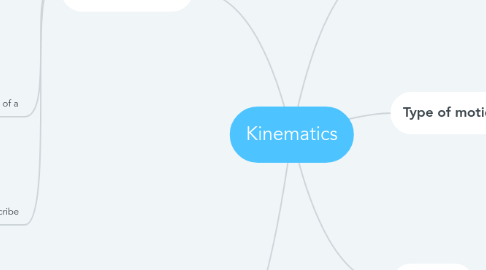
1. Describe motion
1.1. in term of direction of motion
1.1.1. forward/backward
1.1.1.1. check the sign of v
1.1.2. up/down
1.1.2.1. check the sign of v
1.2. (means slow down in general)
1.3. in terms of v
1.3.1. constant
1.3.1.1. (means a = 0)
1.3.2. increasing magnitude
1.3.2.1. (means speed up in general)
1.3.2.1.1. to check if obj is speeding up (acceleration)
1.3.3. decreasing megnitude
1.3.4. zero
1.3.4.1. (means obj stop)
1.3.4.2. (means obj U-turn)
1.4. in terms of a
1.4.1. constant
1.4.2. increasing
1.4.3. decreasing
1.4.4. zero
1.4.4.1. (means obj in constant v)
1.4.4.2. (means no F-net)
1.5. use 1 x adjective and 1 x noun to describe
1.5.1. e.g. velocity increasing
1.5.2. e.g. acceleration constant
2. Graphs
2.1. V-T graph
2.1.1. if all v are positive
2.1.1.1. means obj keep moving forward
2.1.2. if cut x-axis (v = 0)
2.1.2.1. signal a U-turn
2.1.2.2. signal Max height
2.1.3. gradient
2.1.3.1. indicates the a
2.1.3.1.1. area between line and axis
2.1.4. flat line
2.1.4.1. indicates constant v
2.1.4.2. NOT at rest
2.2. D-T grap
2.2.1. a U-turn on the graph
2.2.1.1. indicates a u-turn
2.2.2. if cut x-axis (d = 0)
2.2.2.1. indicates back to start point
2.2.3. flat line
2.2.3.1. indicates at rest
3. displacement = area between line and axis
4. Type of motion
4.1. max height
4.1.1. v = 0
4.2. free-fall
4.2.1. a = g = 10 m/s2 (downwards)
4.2.1.1. regardless of
4.2.1.1.1. direction of motion
4.2.1.1.2. shape
4.2.1.1.3. mass
4.2.1.1.4. location
4.3. direction of motion determined by
4.3.1. sign of v
4.4. circular motion
4.4.1. direction component of v will keep changing
